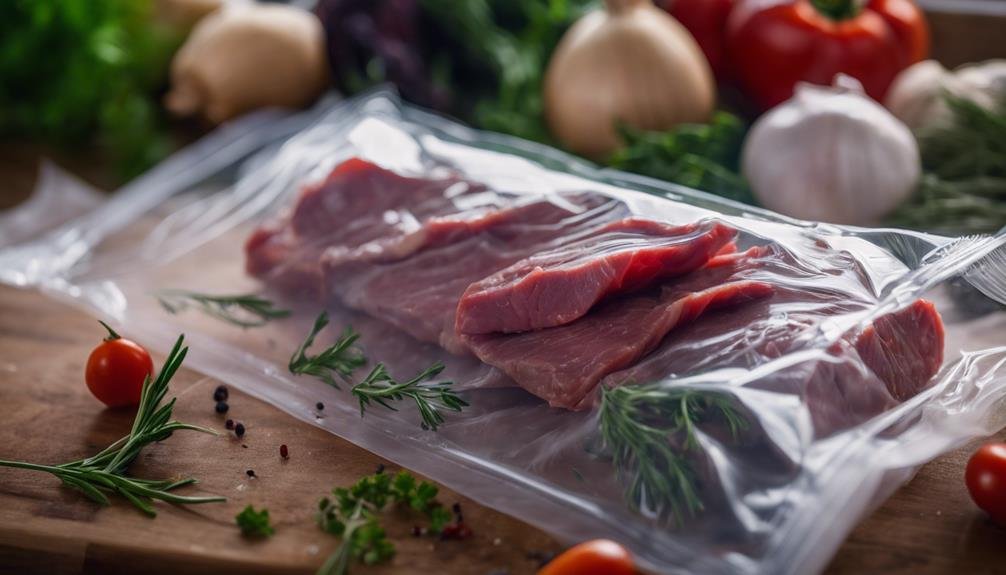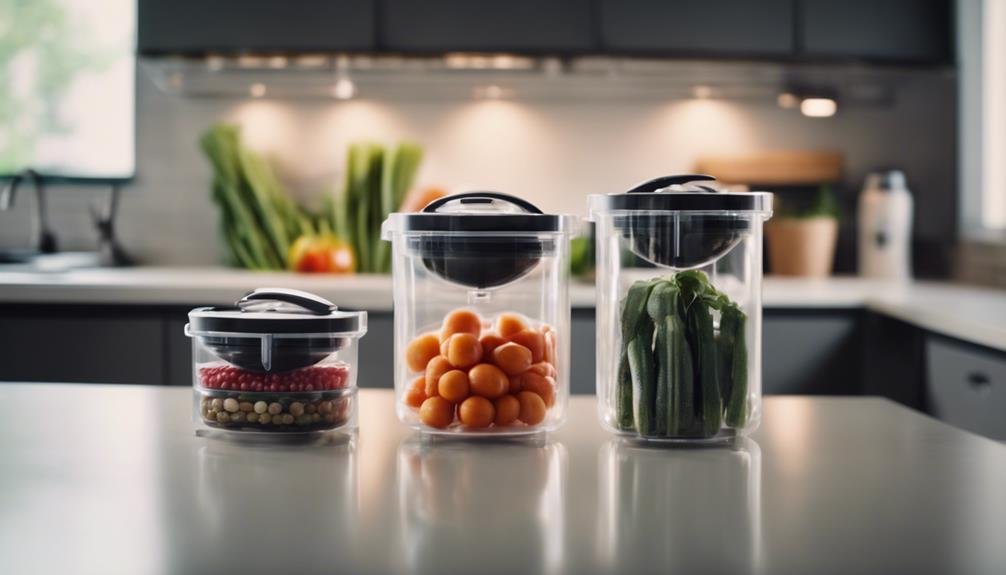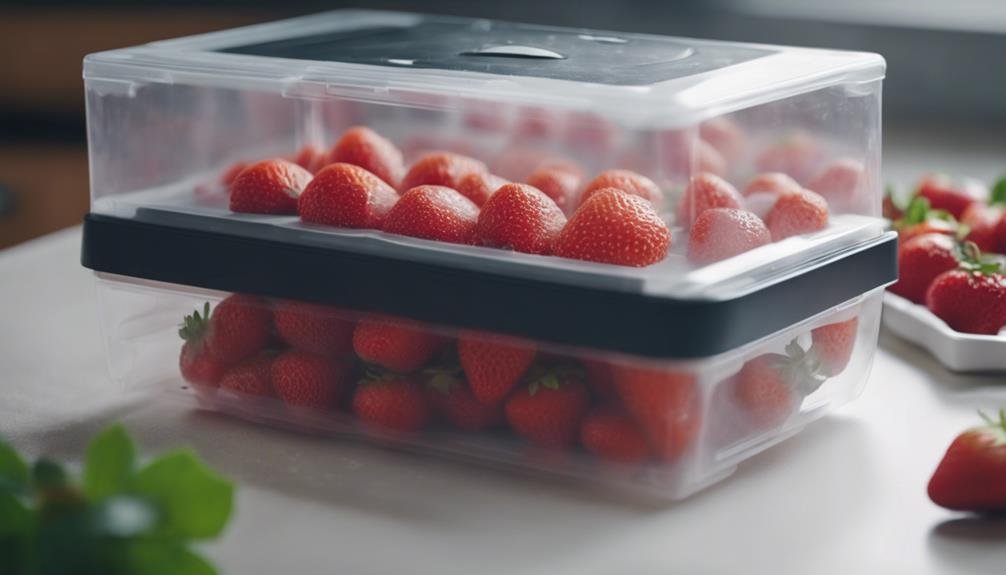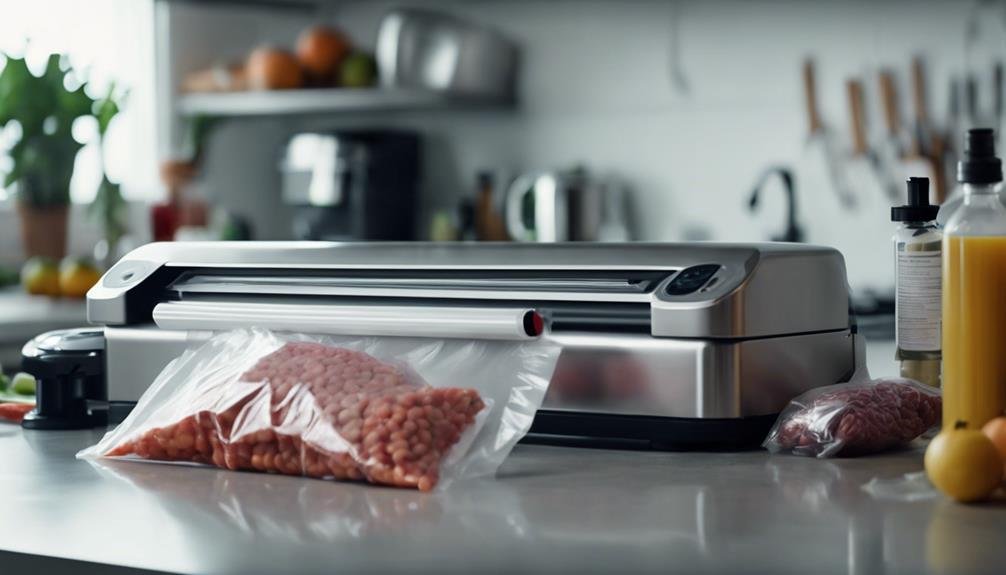Enhance your food preservation skills with advanced vacuum sealing techniques. Adjust vacuum levels to protect delicate items from crushing and use pulse vacuuming for foods high in liquids. Make the most of marinating functions for faster and deeper flavor infusion. Benefit from dual sealing bars for strong, dependable seals, and utilize vacuum canisters to extend the freshness of your foods. Ensure consistent cooking and top-notch results with sous vide compatibility. Customize the sealing process to store liquids safely by partially freezing them beforehand. By mastering these techniques, you'll uncover valuable tips for superior food storage and preparation.
Adjustable Vacuum Levels
When sealing various types of foods, it's crucial to take into account their unique requirements. For instance, delicate items like fruits or soft cheeses can get squished if the vacuum level is too high. By adjusting the vacuum levels, you can prevent crushing these delicate foods while still ensuring a tight seal.
Many advanced vacuum sealers come with multiple pressure settings. These settings give you the flexibility to fine-tune the vacuum process according to what you're sealing. If you're dealing with more robust items like meats or vegetables, you can use a higher vacuum level to remove more air and extend their shelf life.
Fine-tuning the vacuum levels not only helps in maintaining the texture and freshness of different foods but also enhances the overall effectiveness and versatility of your vacuum sealing efforts. By learning how to adjust these levels, you can achieve better results and make the most out of your vacuum sealer. So, next time you're sealing, remember to adjust the vacuum level to match the specific needs of your food.
Pulse Vacuuming
When dealing with fragile or liquid-rich foods, pulse vacuuming offers a more controlled and gentle sealing method. This technique involves intermittent suction cycles during the sealing process, allowing you to monitor and adjust the amount of air removed. By doing so, you can avoid crushing delicate items like bread or berries, ensuring they maintain their shape and texture.
Pulse vacuuming is particularly beneficial when sealing foods with high liquid content. During the sealing process, it helps prevent liquids from being drawn into the vacuum sealer, which can cause leaks and mess. This makes it an excellent choice for soups, stews, or marinated ingredients. The intermittent nature of pulse vacuuming gives you the ability to pause and check the status, ensuring a perfect seal every time.
This versatile approach provides a more precise and customized vacuum sealing experience, catering to a variety of food types and textures. Whether you're preserving the freshness of your produce or preparing meals for sous-vide cooking, pulse vacuuming offers the flexibility and control you need. It's a game-changer in the world of vacuum sealing, making your food preservation efforts more effective and efficient.
Marinating Functions

Vacuum sealing transforms the marination process by allowing flavors to penetrate food more quickly and deeply. When you use a vacuum sealer, you're not just speeding up the marinating time; you're enhancing the entire experience. By creating an airtight seal, the marinade gets pushed into the meat, breaking down fibers and tenderizing it. This results in a more tender and flavorful dish.
Let's break down the benefits of vacuum-sealed marinating:
| Benefit | Explanation | Time Saved |
|---|---|---|
| Faster Marination | Flavors penetrate quickly | Reduces marinating time |
| Better Flavor Infusion | Ingredients distribute evenly through the food | Intense taste experience |
| Tenderizing Effect | Fibers break down for a tender result | Enhances texture |
| Food Preservation | Airtight seal keeps food fresh during marination | Extends shelf life |
Dual Sealing Bars
After mastering the art of marinating with a vacuum sealer, it's time to explore the advantages of dual sealing bars for a more secure and efficient sealing process. Dual sealing bars in vacuum sealers apply heat and pressure simultaneously, providing a stronger and more reliable seal. This technology guarantees airtight seals on both sides of the bag, greatly reducing the risk of leaks or spoilage.
One of the main benefits of dual sealing bars is their efficiency in handling larger bags or multiple bags at once. This feature makes it easier to seal bulk quantities of food or larger items securely, saving you time and increasing productivity. By creating a more robust seal, dual sealing bars also offer added protection against freezer burn, which can extend the shelf life of your sealed items.
For those who often store large amounts of food or need to secure big items, vacuum sealers equipped with dual sealing bars are ideal. They ensure that your food stays fresh for longer periods, minimizing waste and preserving quality. Investing in a vacuum sealer with dual sealing bars can transform your food storage practices, making them more reliable and efficient.
Vacuum Canisters

For an efficient way to store food items like nuts, coffee beans, and delicate snacks, consider using vacuum canisters. These airtight containers utilize a vacuum pump to remove air, creating a secure seal that helps maintain food freshness and extend shelf life. By preventing moisture and odor transfer, vacuum canisters guarantee the quality of your stored items remains intact.
One of the great features of vacuum canisters is their versatility. They come in various sizes, from small to large, to accommodate different storage needs. This makes them perfect for organizing your pantry or refrigerator. Additionally, many vacuum canisters are stackable, allowing you to maximize space efficiently.
Here's why you should add vacuum canisters to your food storage solutions:
- Improved Food Freshness: Removing air keeps your food items fresher for longer.
- Extended Shelf Life: A vacuum seal can significantly prolong the shelf life of perishable items.
- Space Efficiency: Stackable designs help you organize your kitchen more effectively.
- Quality Preservation: Airtight seals protect against moisture and odors.
Using vacuum canisters is a smart choice for anyone looking to enhance their food storage methods. You'll enjoy longer-lasting freshness and a more organized kitchen setup.
Sous Vide Compatibility
Sous vide cooking, which involves sealing food in bags and using a water bath, pairs perfectly with vacuum sealing techniques to guarantee consistent cooking and ideal flavor retention. When you vacuum-seal your ingredients, you secure they're cooked evenly and their flavors are fully infused. This method is widely compatible with most vacuum sealers that create an airtight seal. Whether you're using a high-end machine or a Handheld Vacuum Sealer, you can expect excellent results.
By vacuum sealing before sous vide cooking, you enhance the quality, tenderness, and flavor retention of your food. The airtight environment prevents any loss of moisture or flavor, ensuring your dishes turn out just as you envisioned. It's a game-changer for home chefs aiming to achieve restaurant-quality results without the guesswork.
Using a Handheld Vacuum Sealer could be a convenient and cost-effective option for sous vide cooking. These compact devices are easy to store and use, making them ideal for anyone looking to explore sous vide techniques without a large investment. Remember, the key to sous vide success lies in a good vacuum seal, securing every bite is packed with flavor and cooked to perfection.
Delicate Food Handling

Ensuring delicate foods like soft cheeses, fresh berries, and pastries remain intact during vacuum sealing requires careful handling and specific techniques. You'll need to balance maintaining the integrity of your food while ensuring it's well-preserved.
First, use the manual mode on your vacuum sealer. This allows you to adjust the pressure, giving you control over how much force is applied. Too much pressure can easily crush fragile items.
Here are some tips for effective delicate food handling:
- Freeze first: Slightly freeze delicate items before vacuum sealing. This helps them maintain their shape and prevents squishing.
- Gentle pressure: Always use gentle pressure settings to avoid damaging soft foods.
- Specialized bags: Opt for vacuum sealing bags designed for delicate foods. They're often more forgiving and provide better protection.
- Layering technique: Place a layer of parchment paper between items to prevent them from sticking together and to add a buffer.
Customizing the Sealing Process
To achieve the best results, adjust the vacuum pressure settings based on the type of food you're sealing. Different foods have varying sensitivities, and fine-tuning the pressure guarantees delicate items won't get crushed. For instance, softer foods like berries or leafy greens need lower pressure, whereas firmer foods can handle higher settings.
Customizing the sealing process is crucial to preventing freezer burn and managing excess moisture. For foods with high moisture content, you'll want to modify the sealing time to avoid drawing too much liquid out. This prevents soggy, compromised textures when you later defrost them. Experiment with sealing durations to find the sweet spot that maintains the food's texture and shape.
You might also find it useful to employ techniques like double-sealing or vacuum-pulsing. These methods are excellent for foods that need extra care to avoid damage. Additionally, creating batch-specific settings for different types of produce or meals can streamline your sealing process. This way, you optimize both efficiency and quality, guaranteeing each type of food is sealed under ideal conditions. By customizing your vacuum sealing process, you'll extend the freshness of your food while keeping it in peak condition.
Storing Liquids Safely

When storing liquids, always use vacuum-sealable bags with strong seals to prevent leaks. It's important to take extra steps to make sure your liquids are stored safely and efficiently. Start by partially freezing the liquids before vacuum sealing. This helps avoid spills and guarantees a tight seal. Leave extra space at the top of the bag to accommodate the liquid's expansion as it freezes.
To further safeguard against leaks, use a drip tray or small container during the sealing process. This will catch any potential spills and keep your workspace clean. Don't forget to label your bags or rolls with the contents, date, and any special instructions. This makes it easy to identify and handle them later.
Here are some quick tips for storing liquids safely:
- Partially freeze liquids before vacuum sealing to prevent spills.
- Leave extra space at the top of the bag for liquid expansion.
- Use a drip tray or small container to catch potential leaks.
- Label the bags with contents, date, and special instructions.
Conclusion
You've now got the lowdown on advanced vacuum sealing techniques. By dialing in adjustable vacuum levels, using pulse vacuuming, and exploring marinating functions, you're well-equipped to preserve food like a pro. Dual sealing bars, vacuum canisters, and sous vide compatibility make sure you're prepared for anything. Handling delicate foods and storing liquids safely are no longer a piece of cake. Customize your sealing process and you'll have your food storage game in the bag. Happy sealing!
